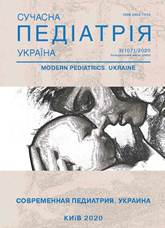Optimization of the system of observation of children with urinary tract infection under the conditions of antibiotic resistance
Keywords:
urinary tract infection, children, antibiotic resistance, surveillance systemAbstract
Algorithms for the diagnosis and treatment of urinary tract infections (UTIs) in children need to be revised and optimized according to current disease trends and new diagnostic capabilities.The aim. To develop a modern diagnostic and treatment system for monitoring children with UTI at different stages of the disease.
Materials and methods. The study included 2754 children with ISS aged 0 to 18 years in the period 2009–2019. Among the patients were outpatients and hospital patients at different stages of UTI. The examination of all patients and the evaluation of the obtained data were carried out with the informed consent of children, their parents and in accordance with the Helsinki Declaration of Human Rights.
Results. We determined that patients with an outpatient plan of 12–18 years with suspected UTI (who do not have fever and other signs of systemic inflammatory reaction) should apply the tactics of delayed ABT based on the results of a negative dipstic test, the appointment of herbal medicine and the possibility of ABT for 3 day of observation if necessary. ABT of empirical choice in the treatment of uncomplicated ISS in children >3 years may be furazidin K (the level of resistance of Escherichia coli in 2019 — 8.0%±21.07). The drug of choice in the treatment of pyelonephritis — ceftazidime (resistance at 14.3%±15.15), in multidrug&resistant conditions and vital signs — ciprofloxacin (resistance — 11.0%±17.5). Urivac multicomponent vaccine therapy is recommended for children >7 years of age with recurrent UTI. Uriclar phytocitrate should be included in the treatment of UTI on the background of mineral disorders in children from 6 years of age with subsequent administration of the drug to prevent reinfection in intermittent mode from 2 months.
Conclusions. The use of the proposed diagnostic and treatment system for monitoring children with UTI will contribute to the rational therapy and prevention of recurrent episodes.
No conflict of interest was declared by the author.
References
Budnik TV, Kvashnina LV, Shpyt MD, Rudyk YuYu, Androsov VО. (2020). The empirical purpose of antibacterial treatment of urinary tract infection in children: argumentation of choice and prognosis of antibiotic resistance risk. Ukrainian Journal of Perinatology and Pediatrics. 1(81): 70–75. doi 10.15574/PP.2020.81.70
Budnik TV, Kvashnina LV. (2020). Influence of vaccine therapy on clinical and laboratory parameters in patients with recurrent urinary tract infection. Medicni perspektivi. 25(1): 109—115. https://doi.org/10.26641/230700404.2020.1.200409
Budnik TV, Kvashnina LV. (2020). Kompleksnyi analiz okremykh faktoriv ryzyku v formuvanni rekurentnoho perebihu infektsii sechovoi systemy u ditei. Zaporizkyi medychnyi zhurnal.2: 32–37.
Budnik TV, Kvashnina LV. (2020). Perspektyvy korektsii mineralnoho dyzmetabolizmu v ditei iz rekurentnym perebihom infektsii sechovoi systemy. Svit medytsyny ta biolohii.3: 42–48.
Budnik TV. (2020). Sposib stratyfikatsii patsiienta iz pidozroiu na infektsiiu sechovoi systemy dlia zastosuvannia antybakterialnoho rezhymu. Simeina medytsyna.1: 53–59.
Ana L Flores0Mireles, Jennifer N Walker, Michael Caparon, Scott J Hultgren. (2015). Urinary tract infections: epidemiology, mechanisms of infection and treatment options. Nature Reviews Microbiology.13: 269—284. https://doi.org/10.1038/nrmicro3432; PMid:25853778 PMCid:PMC4457377
Antimicrobial Resistance: tackling a crisis for the health and wealth of nations. The review on antimicrobial resistance chaired by Jim O’Neill. 2014. 20 p.
Baligyan E, Burke M. (2018). Urinary tract infections in children. Pediatr. Rev. 39(1): 3—12. https://doi.org/10.1542/pir.2017-0007; PMid:29292282
Clark SJ, Kennedy VA, Shortliff LD. (2010). Urinary tract infection in children: when to worry. Urol. Clin. North Am. 37(2): 229—241. https://doi.org/10.2174/1872213X13666181228154940; PMid:30592257 PMCid:PMC6751349
Copp HL, Schmidt B. (2015). Work up of pediatric urinary tract infection. Urology Clinika North America.42: 519—526. https://doi.org/10.1016/j.ucl.2015.05.011; PMid:26475948 PMCid:PMC4914380
Foxman B. (2014). Urinary tract infection syndromes: occurrence, recurrence, bacteriology, risk factors, and disease burden. Infect Dis Clin North Am.28(1): 1—13. https://doi.org/10.1016/j.idc.2013.09.003; PMid:24484571
Jackson EC. (2015, April). Urinary tract infections in children: knowledge updates and a salute to the future. Pediatrics in Review. 36(4): 153—166. https://doi.org/10.1542/pir.36-4-153; PMid:25834219
Leung AK. (2011). Urinary tract infection. Common problems in outpatient pediatrics: specific clinical problems. 1. New York: Nova Science Publishers. Inc: 173—181. doi.org/10.2174/1872213X13666 18122 8154940
Martin Bland. (2015). An introduction to medical statistics: Oxford University Press, 4th edition: 464 p. ISBN 978-0-19-958992-0.
NICE Resource impact report: Urinary tract infection in under 16s: diagnosis and management (CG54). National Institute for Health and Care Excellence; 2018.
Robinson JL, Le Saux N. (2016). Management of urinary tract infections in children in an era of increasing antimicrobial resistance. Expert Rev. Anti Infect. Ther.14(9): 809—816. https://doi.org/10.1080/14787210.2016.1206816; PMid:27348347
Schlager TA. (2016). Urinary tract infections in infants and children. Microbiol. Spectr.4(5). https://doi.org/10.1128/microbiolspec.UTI-0022-2016; PMid:28087926
Shaikh N, Mattoo TK, Keren R et al. (2016, Sep. 1). Early Antibiotic Treatment for Pediatric Febrile Urinary Tract Infection and Renal Scarring. JAMA Pediatr. 170(9): 848—54. https://doi.org/10.1001/jamapediatrics.2016.1181; PMid:27455161
Tandogdu Z, Cek M, Wagenlehner F, Naber K et al. (2014). Resistance patterns of nosocomial urinary tract infections in urology departments: 8-year results of the global prevalence of infections in urology study. World J Urol. 32: 791—801. doi: 10.1007/ s00345-013-1154-8.
Ventola CL. (2015). The antibiotic resistance crisis: part 1: causes and threats. Pharm Ther.40: 277—283.
Downloads
Issue
Section
License
The policy of the Journal “MODERN PEDIATRICS. UKRAINE” is compatible with the vast majority of funders' of open access and self-archiving policies. The journal provides immediate open access route being convinced that everyone – not only scientists - can benefit from research results, and publishes articles exclusively under open access distribution, with a Creative Commons Attribution-Noncommercial 4.0 international license (СС BY-NC).
Authors transfer the copyright to the Journal “MODERN PEDIATRICS. UKRAINE” when the manuscript is accepted for publication. Authors declare that this manuscript has not been published nor is under simultaneous consideration for publication elsewhere. After publication, the articles become freely available on-line to the public.
Readers have the right to use, distribute, and reproduce articles in any medium, provided the articles and the journal are properly cited.
The use of published materials for commercial purposes is strongly prohibited.

